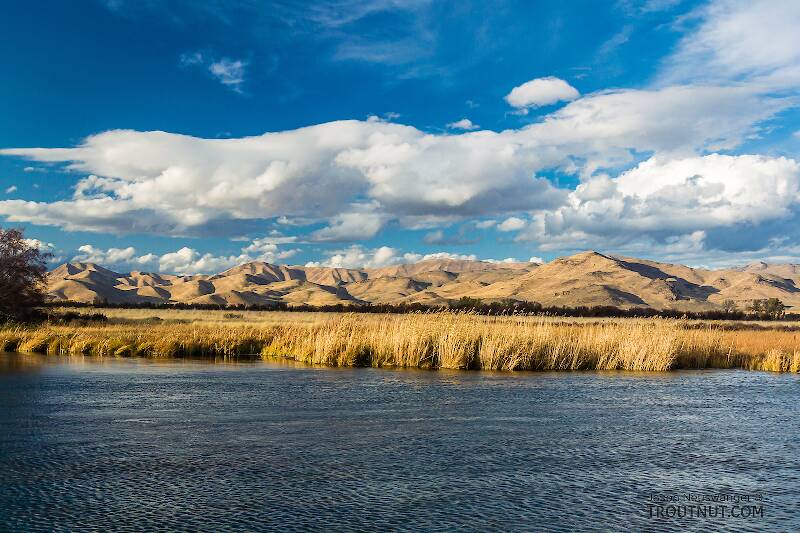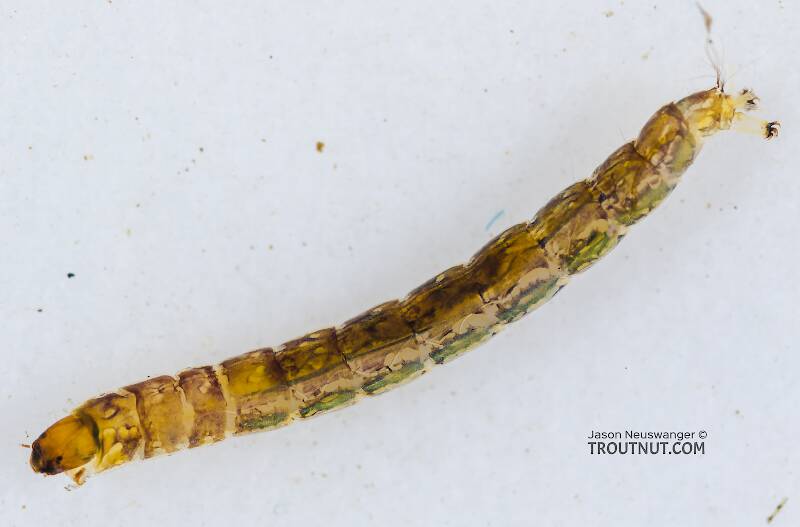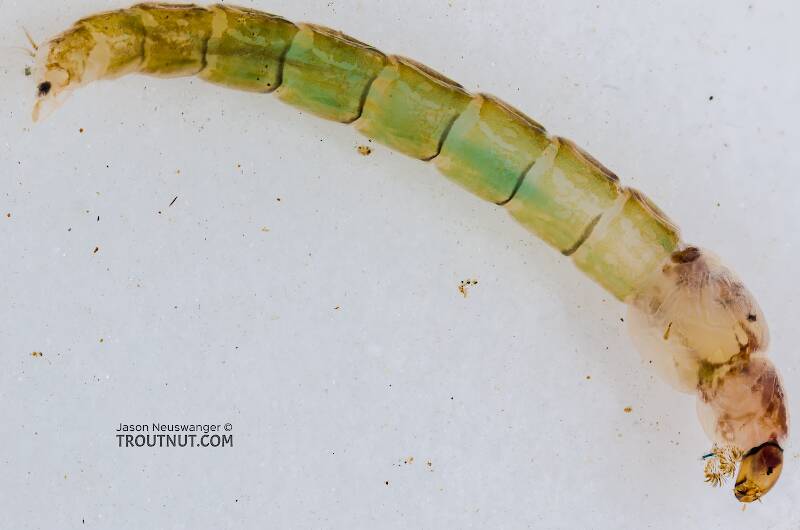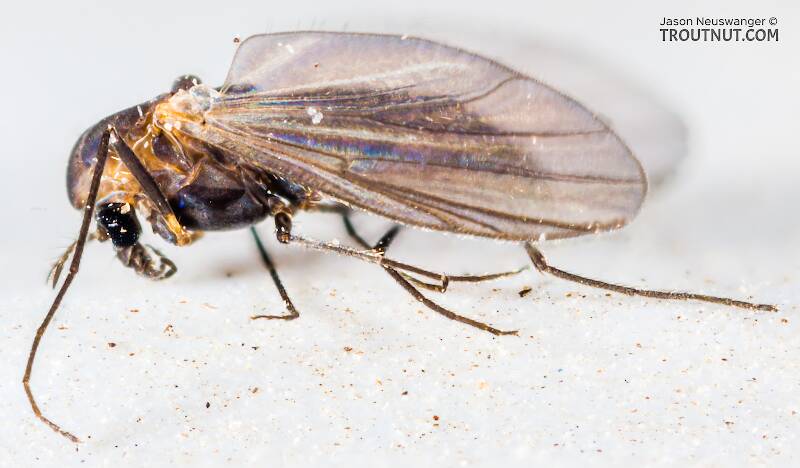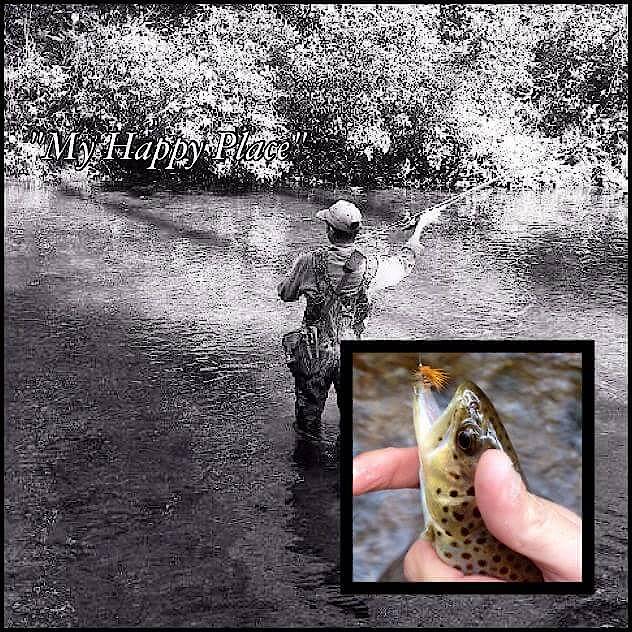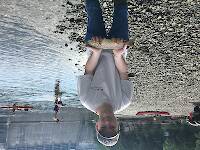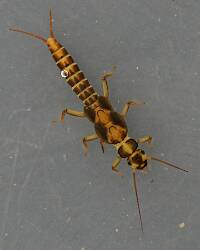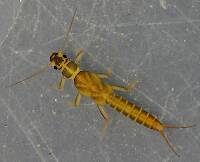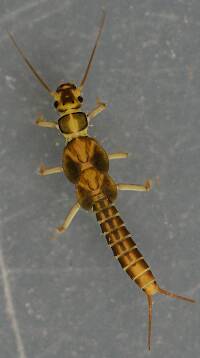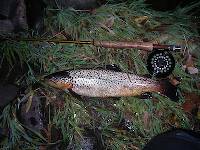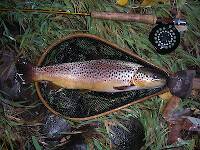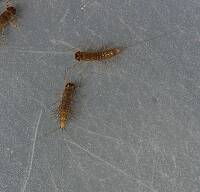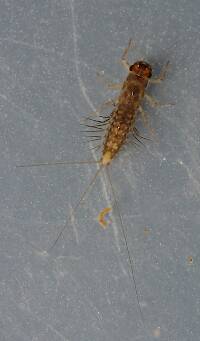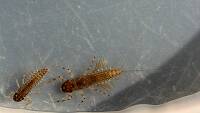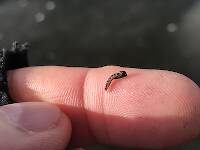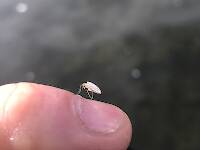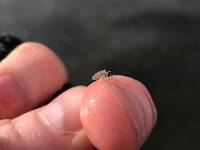
Hex Mayflies
Hexagenia limbata
The famous nocturnal Hex hatch of the Midwest (and a few other lucky locations) stirs to the surface mythically large brown trout that only touch streamers for the rest of the year.
Featured on the forum

This dun emerged from a mature nymph on my desk. Unfortunately its wings didn't perfectly dry out.

Troutnut is a project started in 2003 by salmonid ecologist Jason "Troutnut" Neuswanger to help anglers and
fly tyers unabashedly embrace the entomological side of the sport. Learn more about Troutnut or
support the project for an enhanced experience here.
This topic is about the True Fly Family Chironomidae
Midges are the most important aquatic insects in some places, especially fertile spring creeks where they are extremely abundant and the current is so slow that it's efficient for trout to surface feed on very tiny insects.Some midges are large, up to hook size 14, but the majority are size 22 or smaller. The number of genera and species is hopelessly huge for angler entomologists to ever learn, and the identifing characteristics often require slide-mounting tiny parts under high-powered microscopes. Even the most Latin-minded fisherman must slip back to the basics--size and color--to describe his local midge hatches.
Example specimens
Goose
Posts: 77
Posts: 77
Goose on Oct 24, 2006October 24th, 2006, 2:07 am EDT
Hi Jason & Gonzo! I did well over the weekend by fishing some midge pupa imitations as nymphs and in the film. Where does one find midge larva to inspect for pattern imitation? I fished the pupas and larvas on 5x tippet and it seemed to work well. Do midges live in the silt or on the bottom of rocks, etc.? I have the book by Ed Koch and ?, the other name escapes me for the moment, but it doesn't exactly say where they are found. Midges are about the game in in town during the winter months so I thought I'd learn a little about them. Thanks
GONZO on Oct 24, 2006October 24th, 2006, 3:43 am EDT
Hi Goose,
"True" midges (Chironomids) are a vast and widely adapted group of the true flies, or Diptera (which also includes such nasties as house flies, mosquitoes, and the dreaded black flies that torment anglers). They are found in nearly every kind of aquatic environment from the largest lakes to little brooks. Pinning down species and assembling hatch charts is an impractical task even for the most dedicated and bug-geeky angler. You will generally find the populations to be highest in slower, silt-bottomed or weedy water.
You'll notice that what pass for hatch charts in Midge Magic are mostly records of fly patterns Holbrook found to be successful on Big Spring (primarily) at different times of the year. To extend this to other waters and get specific about identification would have been an astronomical task.
You'll also notice that one of Don's primary tools in narrowing pattern selection is a stomach pump. This is certainly one way to do it, but I cringe at the thought of this tool being regularly employed by anglers who might not be as careful as Don is when using it. Personally, I've always found it a bit inconsiderate to deprive a fish of its last meal unless it is truly going to be that fish's last (as in final) meal.
My best advice for selecting patterns is to try to capture a few of the recently hatched adults. Midge larvae and pupae patterns can and should be quite simple, and matching the body color of the adult (both base color and rib or markings, if you want to get fussy) should almost always work out. Good luck and don't strain your eyes! :)
"True" midges (Chironomids) are a vast and widely adapted group of the true flies, or Diptera (which also includes such nasties as house flies, mosquitoes, and the dreaded black flies that torment anglers). They are found in nearly every kind of aquatic environment from the largest lakes to little brooks. Pinning down species and assembling hatch charts is an impractical task even for the most dedicated and bug-geeky angler. You will generally find the populations to be highest in slower, silt-bottomed or weedy water.
You'll notice that what pass for hatch charts in Midge Magic are mostly records of fly patterns Holbrook found to be successful on Big Spring (primarily) at different times of the year. To extend this to other waters and get specific about identification would have been an astronomical task.
You'll also notice that one of Don's primary tools in narrowing pattern selection is a stomach pump. This is certainly one way to do it, but I cringe at the thought of this tool being regularly employed by anglers who might not be as careful as Don is when using it. Personally, I've always found it a bit inconsiderate to deprive a fish of its last meal unless it is truly going to be that fish's last (as in final) meal.
My best advice for selecting patterns is to try to capture a few of the recently hatched adults. Midge larvae and pupae patterns can and should be quite simple, and matching the body color of the adult (both base color and rib or markings, if you want to get fussy) should almost always work out. Good luck and don't strain your eyes! :)
Troutnut on Oct 24, 2006October 24th, 2006, 6:41 am EDT
I've re-filed this topic in the midges section. Be sure to check out the main midges page if you haven't yet.
I don't have much to add beyond what Gonzo wrote. I've never lived close enough to a fertile spring creek to fish winter surface activity caused by midges. I see the bugs sometimes, but never enough to bring the trout up top.
All my winter fishing success has come with deep nymphs. Some of the next year's hatches, like Hendricksons, Isos, and Golden Stones, will already be grown to nymphs of substantial size by December, and I've had success with imitations of those insects tied to match their winter sizes.
I don't have much to add beyond what Gonzo wrote. I've never lived close enough to a fertile spring creek to fish winter surface activity caused by midges. I see the bugs sometimes, but never enough to bring the trout up top.
All my winter fishing success has come with deep nymphs. Some of the next year's hatches, like Hendricksons, Isos, and Golden Stones, will already be grown to nymphs of substantial size by December, and I've had success with imitations of those insects tied to match their winter sizes.
Jason Neuswanger, Ph.D.
Troutnut and salmonid ecologist
Troutnut and salmonid ecologist
GONZO on Oct 26, 2006October 26th, 2006, 4:03 am EDT
Goose-
Just a few afterthoughts about winter midging that might be of help--most winter midges tend to be dark. This is generally true of most winter hatches. Other "dark" winter hatches include the winter or early spring hatches of stoneflies like the Capniidae (Snowflies) and Taeniopterygidae (Willowflies) and even the "winter" caddisflies like Dolophilodes distinctus (Medium Evening Sedge), Frenesia missa (Dot Wing Winter Sedge), and (to a lesser extent) Psychoglypha subborealis (Snow Sedge).
These may offer some other possibilities, in addition to the midges. When in doubt, fish a dark fly. And, for surface activity, the "old reliable" Griffith's Gnat is still a very effective pattern. I like to add a post of white Hi-Viz for...well...high viz! :)
Just a few afterthoughts about winter midging that might be of help--most winter midges tend to be dark. This is generally true of most winter hatches. Other "dark" winter hatches include the winter or early spring hatches of stoneflies like the Capniidae (Snowflies) and Taeniopterygidae (Willowflies) and even the "winter" caddisflies like Dolophilodes distinctus (Medium Evening Sedge), Frenesia missa (Dot Wing Winter Sedge), and (to a lesser extent) Psychoglypha subborealis (Snow Sedge).
These may offer some other possibilities, in addition to the midges. When in doubt, fish a dark fly. And, for surface activity, the "old reliable" Griffith's Gnat is still a very effective pattern. I like to add a post of white Hi-Viz for...well...high viz! :)
Justin483 on Jan 12, 2015January 12th, 2015, 1:59 pm EST
Great Winter Midge tip Gonzo. That's all I've been hearing about is go darker in color and smaller.
While I have you here, and you seem to know quite a bit about this topic, I was was wondering if you could help me with a serious problem I'm having??
I live in North Georgia. My local Stream is the Public Access of the Soque River. It's a Freestone river, smaller size. I've been fishing it for a while now but still haven't been able to figure out any of the seasons, or insect activity. Since I've started most times I've been blind guessing. Anyways, sorry I kinda went off topic. My question is would you recommend a smaller black Midge for my stream for the Winter right now? Also, would you be willing to share a few patterns with me so I can tie some up?? I've been frustrated really bad cause there is plenty of fish activity and I have a pretty good run of BAD luck lately. Lol.
While I have you here, and you seem to know quite a bit about this topic, I was was wondering if you could help me with a serious problem I'm having??
I live in North Georgia. My local Stream is the Public Access of the Soque River. It's a Freestone river, smaller size. I've been fishing it for a while now but still haven't been able to figure out any of the seasons, or insect activity. Since I've started most times I've been blind guessing. Anyways, sorry I kinda went off topic. My question is would you recommend a smaller black Midge for my stream for the Winter right now? Also, would you be willing to share a few patterns with me so I can tie some up?? I've been frustrated really bad cause there is plenty of fish activity and I have a pretty good run of BAD luck lately. Lol.
Martinlf on Jan 12, 2015January 12th, 2015, 3:06 pm EST
Justin, Gonzo has moved off the board at this time, so you may not hear from him. I'll bump up another midge thread that will provide some good patterns.
"He spread them a yard and a half. 'And every one that got away is this big.'"
--Fred Chappell
--Fred Chappell
Justin483 on Jan 12, 2015January 12th, 2015, 3:30 pm EST
Thanks Martin.
Justin483 on Jan 12, 2015January 12th, 2015, 3:31 pm EST
Sorry, but how will I know where this thread is located??? I'm new here, sorry again.
Martinlf on Jan 12, 2015January 12th, 2015, 3:35 pm EST
I just moved the thread in question to the top of the list. If I were fishing that river, I'd use a size 24-20 black zebra midge now, and a hare's ear nymph size 18-10 once the water warms up. Success in your river will probably depend more on presentation than the fly, especially if the fish have been caught multiple times. Using a thingamabobber and enough weight to keep it moving slightly slower than the current may help. Set the indicator about 1 and 1/2 times the water depth. The quickest path to success will be to hire a good guide and let him teach you the water there and how to fish it.
"He spread them a yard and a half. 'And every one that got away is this big.'"
--Fred Chappell
--Fred Chappell
Justin483 on Jan 13, 2015January 13th, 2015, 1:02 am EST
Big thanks Martin. I'll do just that. I was heading in that direction anyways. Won't be able to book a guide though, entirely too much money I don't have. Thanks again.
Martinlf on Jan 14, 2015January 14th, 2015, 11:28 am EST
You're welcome. In a couple of threads you now have good basic information that can lead to success if you are persistent. Best of luck!
"He spread them a yard and a half. 'And every one that got away is this big.'"
--Fred Chappell
--Fred Chappell
Quick Reply
Related Discussions
Topic
Replies
Last Reply
4
Jan 19, 2015
by Kschaefer3
by Kschaefer3

